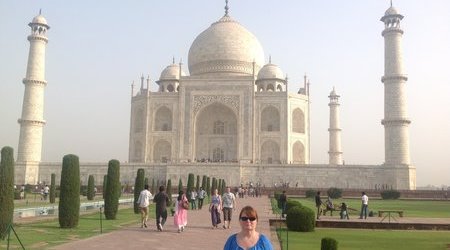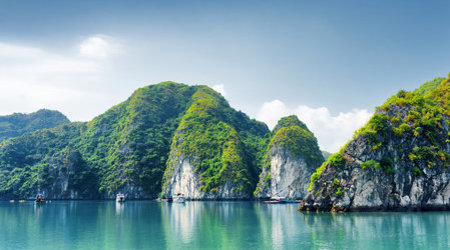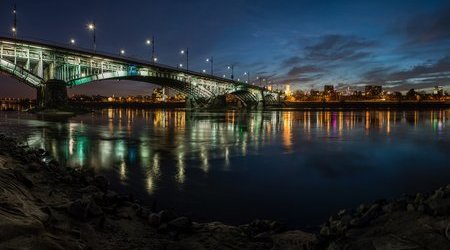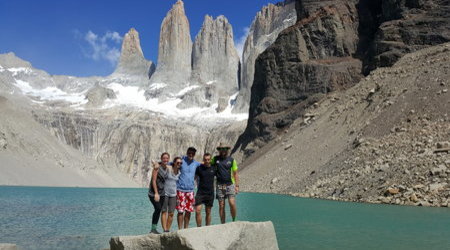Please enter your username and password to logon to the member pages
Accessible India: Where There’s Magic Around Every Corner
25 Oct 2022
The Adventure Begins
Travel has been my passion and my career for more years than I care to remember, so you can imagine the number of places I’ve been fortunate to visit throughout the world. Yet of all the destinations I’ve had the pleasure to visit, one adventure stands out as the jewel in the crown - my unforgettable 11-day tour of India. The Indian Tourist Board were just as excited about my visit as I was, feeling their wonderful country has much to offer disabled travellers looking for the experience of a lifetime - with good levels of accessibility, and much improved facilities for wheelchair-users and people with limited mobility.
I was certainly interested to see how accessible India could be – especially since an increasing number of disabled travellers are looking to reach out beyond the Mediterranean beaches in pursuit of exotic barrier-free destinations that offer outstanding sight-seeing opportunities. Ahead of me lay the wonders of historical Delhi, the Taj Mahal, Agra Fort, Jaipur, Sikandra – and many more magical places. In the past I’d only seen them upon the pages of books or as mystical backdrops to films and documentaries – now I was about to have the pleasure of discovering them for myself – and I could hardly wait.
Delhi Old and New
After arriving at New Delhi's impressive new airport (via Bahrain) I had a relatively quiet and trouble-free transfer to the Hotel Maidens in North Delhi. As it was now 5.30pm local time and I hadn't caught much sleep during my flight, I was pleased to see the welcoming sight of my bedroom, where the irresistible looking bed was far too appealing to ignore. And so, to bed. My first daylight experience was driving (well, being driven to be precise) from North Delhi to the southern part of the city, for my visit to the Taj Palace Hotel where I was scheduled to undertake my first inspection and audit.
The journey to the hotel was an experience in itself. Travelling along Delhi's equivalent to the M25 presented me with a myriad of emotions. At times it was thrilling, at others it was scary - but above all it was a real eye-opener. The ring road was a highway for every mode of transport (old and new, slow and fast). But whilst bicycles and carts competed with gusto against honking motorbikes, cars, trucks, and buses swerving from lane to lane (some with passengers clinging on to the sides), I was amazed to see that no-one hit anybody else - nor did anyone show signs of road rage. (So, nothing like the M25, really!)
The Taj Palace Hotel is a real gem of a property. The members of staff are extremely friendly and welcoming, and I noted how attentive they were with all guests. The fully adapted room is easily accessed via a ramp at the entrance, and I found it to be very well appointed. Hotel facilities are of a high standard and the pool area is a pleasant place to relax after your morning excursions.
My first excursion was to the fascinating Qutab Minar - the tallest stone tower in India which has been made accessible by the installation of several ramps, and the tower is a very worthwhile place to visit with a very interesting history dating back to 1199.
The excursion also gave me the opportunity to marvel at the imposing India Gate, Parliamentary buildings, and the President's palace, which is home to no less than 340 rooms.
Although I’d only spent a few short hours in this fascinating country, I was already captivated by the Indian people, their rich history, and the exciting atmosphere I found myself in. It really was a whole new experience, and my early impressions couldn’t have been more positive.
Jama Masjid, Chadni Chowk, Raj Ghat and Humayan’s Tomb
The following morning saw an early start in an effort to avoid the rush hour traffic, as we headed off to visit Jama Masjid of Agra - one of Asia's largest mosques.
Once again, we tackled the ring road race track. Today, however, the challenge was stretched even further when I noticed that in the inside lane (if there is such a thing here in Delhi) there was a bull elephant as large as you like going about his business in a most nonchalant fashion. He actually turned out to be the first of three elephants I would see before reaching my destination.
The Jama Masjid mosque is built out of red sandstone and features delicate decorations in white marble. These are then complimented by calming blue décor which adorns the walls and ceilings.
After visiting the famous mosque, I took a ride along Chadni Chowk in a native cycle-rickshaw. This mode of transport is very popular in India and it's surprising how effective they are for getting from A to B. The ride was a real experience with the guy pedalling as fast as he could down the narrow streets that were populated by bullocks and carts on one side and tuck tucks on the other.
It was amazing to see the locals setting up for the day there with their colourful offerings of flowers, food, fabric, fresh fruit, pots and ceramics - and every other form of saleable item. It was a sight to behold, and almost as if I had stepped back in time to India of old. Truly memorable!
Our next stop was Raj Ghat where Ghandhiji was cremated. I'm pleased to report that it was accessible for most part, and truly amazing to still be in the centre of Delhi whilst surrounded by a peacefulness that was only broken by the constant sweet notes of birdsong.
And the variety of birds you can see is staggering - from small common garden birds to parakeets, crows, circling kites and other birds of prey. Upon leaving Raj Ghat, the therapeutic feathered chorus was replaced by honking horns and the sounds of hectic life in a modern city. My next stop was a visit to Humayan's tomb, which is another very worthwhile historical site to experience - and again mainly accessible, apart from the last staircase of this precursor of the Taj Mahal.
When I visited it was the Hindu festival of Goddess Durga. This is celebrated in many ways, including fasting for a single day or up to seven days, the shaving of hair, and the sacrifice of animals in the street. In fact, I witnessed the sacrifice of a lamb, a goat and a chicken, before seeing a little girl of around two years of age having her head shaved. It all made pretty sad viewing to be honest, and the little girl seemed very distraught to see her locks falling to the ground. I do however accept it is a local ritual and did appreciate the colour and excitement that was mounting when I left the celebrations.
My afternoon was spent at the Anna Ruche logical site and inspecting four hotels, where once again I was able to witness smiling faces, excellent service, and superb facilities.
Agra Awaits
The following day saw me saying goodbye to Delhi for the journey to Agra. The trip took us along the new Express Way, which was 5 years in the making but has now reduced the journey from Delhi to Agra substantially and there are several adapted comfort breaks on the way. The land north of Delhi is very flat and mainly comprises miles and miles of farmland; but the nearer we got to Agra the temperature increased dramatically and the fields were populated by local farmers - men, women and children - all working on the land with their rustic carts being pulled by loyal oxen and donkeys.
As we approached Agra we crossed the Yamuna River where a herd of water buffalo were basking in the muddy water alongside children enjoying their daily dip. The traffic in the centre of Agra was just as hectic as that witnessed in Delhi with carts, tuk tuks, cycles, coaches, and cars all competing for the same two lanes. It was noted however that cows clearly had priority above everything else - but as they are sacred animals it was hardly surprising. So, we had no option other than to manoeuvre around them.
In the distance I caught my first glimpse of the amazing Taj Mahal, and as we took the main road into Agra we could see monkeys watching the traffic and chattering among themselves on the windowsills of derelict buildings. Now I do realise that these chummy characters are very nifty souls and will happily steal anything edible from anything or anyone, but they did look really innocent and endearing.
The Taj Mahal at Sunrise
A 5.30am start to the day may not be everybody's cup of tea but with a sunrise visit to the Taj Mahal on the agenda, I needed no encouragement to turn in early and be well prepared for the following morning.
Sunrise is most certainly the best part of the day to enjoy this wonderful treasure house of India. The Taj Mahal proved to be everything I expected it to be - and more.
Built by the Mughal Emperor Shah Jahan as an expression of his love for his wife, this magnificent monument is indeed one of the greatest and most romantic buildings in the world. The days of an emperor in residence here may be long gone but I was intrigued to discover a pair of golden eagles had made it their home. Rather regal I thought.
The palace has access ramps throughout the visitor area right up to the very last sections into the main building, which can only be reached via stairs. The gardens however can be enjoyed in all their glory and photographs with the Taj Mahal in the background will give you wonderful memories of a holiday that is most definitely exotic. The area leading up to the last section is very flat, and it is here - perched in front of the water fountains - you will find the famous bench that is now affectionately known as Diana's bench.
Upon leaving the Taj Mahal, our next stop was a sightseeing tour of Agra City and a visit to the Bagar Fort - the seat of the stronghold of the Mughal emperor under successive generations.
Bagar Fort is another extremely impressive example of Mughal architecture, which also benefits from having plenty of ramps to ensure most areas are accessible. This is good news indeed for tourists with walking difficulties - and proves once again that India is keen to cater for the needs of disabled people.
The Road to Jaipur: Fatehpur Sikri, Bharatpur
It was now time to move on to our next destination, Jaipur. And, as we crossed the Yamuna River, the banks were vibrant with colour with locals busily laying out their clothes to dry in the warm sun. Beyond which, every spare piece of land was occupied by teenagers and young boys mostly playing cricket (which I've been reliably informed is not just a sport in India - but almost a religion).
We pass a camel towing a cart of supplies, there are street vendors with home-made contraptions called jugaars, where juice is sold from sugar canes; and I spy what must have been a builders’ merchants - not because there was a yard full of construction material and big brawny men in hard hats but merely for the reason of there being a great mound of sand and blocks of bricks spilling out onto the street.
Eventually we arrived at Fatehpur Sikri - an abandoned city, which was built by the great Mughal Emperor Akbar in the late 16th century but was abandoned soon afterwards when the water wells ran dry. It remains today much the same as it was over 300 years ago. Most of this site is accessible and has been fitted with ramps and adapted washroom facilities.
On the journey to Jaipur we stopped for lunch at The Hotel Bagh in Bharatpur, which proved to be the perfect relaxing retreat after the hustle and bustle of Delhi and Agra. This hotel has wonderful gardens and is a must for tourists who are looking escape the hectic schedule for a couple of days of peace and tranquility. The area is also an ornithologists paradise with a huge selection of birds to watch, and I enjoyed several minutes being entertained by the antics of a family of owls.
After lunch, we are back on the road to Jaipur, which would take us approximately three hours to reach. And this proved to be the perfect excuse for taking time to sit back relax and enjoy the varied scenery of this wonderful country.
Luxury in the Pink City
In Jaipur I had the pleasure of discovering the sumptuous 5-star LaLiT hotel - one of the finest luxury hotels in the city and conveniently located near Jawahar Circle.
The hotel was pristine, beautifully decorated and very well-appointed - and as for the staff they were faultless and included a fine gentleman with a 14-foot moustache coiled underneath his regal looking turban. Jaipur is the capital city of the state of Rajasthan and is known for its remarkable gridded street system. With awesome fortresses, palaces, temples and beautiful havelis; Jaipur is a popular tourist destination offering royal attractions and cultural ones with traditional handicrafts and spectacular jewellery.
I was advised that the best time to visit the city is between October and March when the climate is a very pleasant temperature; and even though it wasn't unbearably hot for my mid-April visit I could really feel the strength of the sun.
The Final Chapter
It really was a great privilege to discover the fascinating elements that make up this unique country - the affluent and successful of new India living alongside the less privileged of old India. The happy faces and polite manners, the rich history, and wonderful culture. The temples and places; the scenery and wildlife. India is like no other holiday experience on earth.
Apart from being known as the Pink City (all of the buildings within the city gates were painted pink in honour of the visit by King Edward VII), Jaipur is also referred to as 'the city of colours' due to the bright saris worn by all of the women every day of the week. The streets were awash with these resplendent dresses in bright orange, purple, yellow, pink and red with gold edges. And it doesn't matter whether the women are shopping, working in the fields or worshipping at the temple, a burst of colour is the prerequisite ensemble.
En route to a 'surprise' event that had been arranged by my hosts, I noticed that the tuk tuks in Jaipur are much larger than those in Delhi, and that’s because they are mainly used as taxis for local people. Whilst journeying through the streets, we were slowed shown considerably by a funeral procession, where the coffin was being carried through the street and followed by a meandering line of mourners: friends and family members, with all of the men wearing a white cap as a mark of respect to the deceased.
After leaving the boundary of the pink city, we turned off the road and ventured down a track for about two miles to our 'surprise destination. To my surprise, the welcome reception was performed by a herd of elephants, with the bull (presumably the head of the herd) bejewelled and decorated in his finest attire and standing with grace and authority. But this was to be no ordinary animal viewing and photo opportunity, as sport was on the agenda in the form of polo on elephants. The match was extremely entertaining and some of us actually participated in it. Now, to be honest, this was a bit scary to start with as it was such a long way up, but once I got used to the size, height and lumbering movement of these magnificent animals I felt in very safe hands (or maybe I should say trunk). What a wonderful experience!
The following morning, we ventured to the city palace, where the Maharaja and family still live in one enormous wing today; whilst the rest of the palace has been made into a museum where the history of the textiles, clothing and the armoury are displayed. I found everywhere to be accessible by ramp - except the armoury as this can only be reached by a staircase. We finished the city tour at the Jantar Mantar - the astronomical observatory which dates back to 1726 and is one of five such astronomical wonders constructed in India and still providing accurate predictions in the 21st century. Most of the area and gardens around this site is accessible.
My final evening in Jaipur was spent in a futuristic tent site, which gave everyone in my party the perfect opportunity to soak up their last views of India in a natural environment. This tour had opened my eyes to a whole new world of opportunity for disabled travellers looking to widen their horizons. With the hotel and tour audits now safely stored away in my case, I had all I need to produce my final reports. I looked across the landscape before retiring for the evening - and there I spied a camel transporting a family in a cart alongside motorised vehicles. Now that could only happen in India, and that's precisely why I love it!







